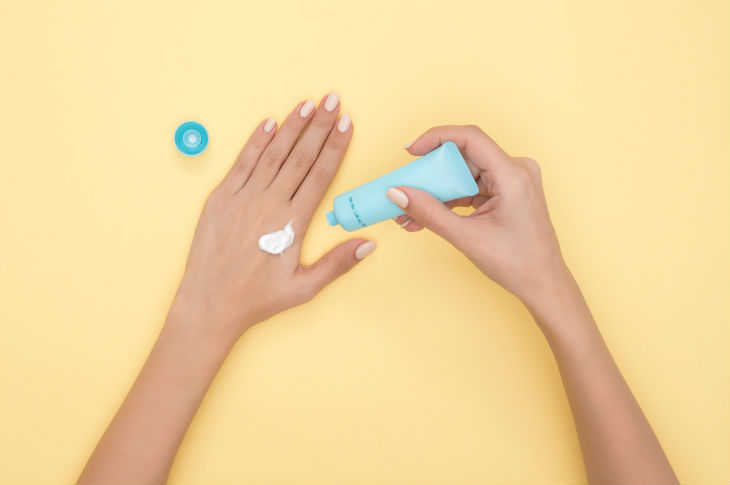
In the excitement of the summer season, it’s easy to forget you need to take extra steps to ensure you are staying sun-safe with ample SPF. For the unacquainted, SPF refers to “sun protection factor,” or the amount of harmful UV-A and UV-B rays that your sunscreen filters out. The higher the SPF, the higher your protection against photo-damage that can cause skin cancer and premature aging.
Of course, you might have some questions—like, do I really need an SPF 70? Do my kids require more sunscreen than I do? Does clothing that boasts additional SPF really work? To answer all your burning questions about SPF (excuse the pun), we asked two top dermatologists to weigh in. Here’s what they had to say.
How much SPF should I wear on my face?
Dermatologists will recommend everyone wear at least SPF 30 and apply every two hours, according to Orit Markowitz, MD, board-certified dermatologist and the Director of Pigmented Lesions and Skin Cancer at Mount Sinai Hospital in New York City. “However, your head and neck are areas that get the most exposure and especially your nose, which is why 80 percent of skin cancers occur on the head and neck,” says Markowitz. She recommends bumping your SPF up for face if you can, “reapplying at least every two hours.”
Also, people typically apply way too little sunscreen, says Josh Zeichner, MD, Director of Cosmetic and Clinical Research in the Department of Dermatology at Mount Sinai Hospital. “In order for you to get the level of protection labeled on your bottle of sunscreen, you must apply enough,” he explains. “I typically recommend a quarter size dollop of sunscreen for the face.”
How about on my body?
Clothes won’t necessarily protect you completely from sun exposure. “A white cotton T-shirt will typically have a SPF of 15, meaning that you are protected for only 15 minutes in the sun,” says Markowitz. “Therefore your morning routine should include applying sunscreen of at least 30 SPF on your body, similar to your face, every day.”
To cover your whole body, you will need enough sunscreen to fill a shot glass. “That means a quarter-sized amount for each of your arms, two quarter-sized amounts for your chest, two for your back, two quarter-sized amounts for your abdomen, and four quarter-sized amounts for each of your legs,” says Zeichner, who expects this is a lot more sunscreen than you’ve ever used before. “If you still have the same tube of sunscreen on Labor Day that you bought for Memorial Day, you are not using enough.” He says a typically-sized four-ounce bottle of sunscreen could easily be used in one week if you are applying enough to your whole body.
How much SPF should my kids wear?
Zeichner says kids should still be wearing at least SPF 30, just like adults. “In children, I usually recommend a mineral-based sunscreen that uses zinc oxide, and because children are smaller than adults, you don’t need as much volume,” he says. For this, you’re going to want to eyeball the difference. If they are half your size, give them about half as much as you’d put on yourself.
Monitor your kids’ application, and make sure they reapply, says Markowitz. If they are exercising, sweating, or spending time in the water, they should reapply more often. “The best way to get children on board with wearing sunscreen is to model good sunscreen habits and as a parent apply sunscreen, and reapply often with your children,” she explains.
Is SPF makeup typically as protective as applying sunscreen as an individual step in your skincare routine?
You probably use additional sunscreen on your face, even if your makeup contains SPF. While some brands of makeup do contain enough SPF, Zeichner says most people aren’t applying as much makeup as they should SPF. With that in mind, it’s better to play it safe and use both. “However, using makeup with SPF over your traditional sunscreen will give you an added layer of protection,” he stresses.
Markowitz recommends that patients “apply sunscreen during their morning routine, after they moisturize and before they apply their make-up” in order to “stress the importance of using sunscreen whenever possible.”
Does SPF clothing work? How does it work?
Indeed, it does. Since SPF is regulated by the FDA, anything—whether it’s sunscreen, cosmetics, or clothing—you can trust the products work the way they are supposed to. “Clothing with protection from the sun is typically labeled as having UPF, or ultraviolet protection factor,” says Zeichner. “It essentially works by physically blocking UV rays from penetrating through the fabric into the skin.”
Makowitz is a big fan of SPF clothing, saying it “works very well as it provides a physical barrier against UVA and UVB rays,” whether it’s created with a tight weave or through fabric additives that essentially provide additional protection against harmful UV rays. Garments typically can be assigned SPF up to 50+, says Markowitz.
How frequently should I apply SPF?
Every two hours, says Zeichner. If you go on a run and sweat a lot, reapply immediately. If you’ve been in the pool or ocean, reapply immediately when you get out.
Is getting a tan bad, even if I use sunscreen and never burn?
In short, yes. “Getting a tan, even if you use sunscreen and never burn, is a bad idea,” says Markowitz. “Constant sun exposure overtime without sunburns may still lead to skin cell deterioration, wrinkles, and eventually skin cancer.” Fair-skinned people especially tend to develop skin cancer much faster and easier with regular unprotected sun exposure, though darker complexions are still at risk of skin cancer.
If you are tanning at all, you know you are getting exposed to harmful UV light and “may cause long-term damage to the skin,” says Zeichner. So, try to prevent a tan; don’t encourage it.
Are sunscreens safe? What are EDCs, and are they found in sunscreen?
Some studies have shown that chemical ingredients in sunscreen can be found in the bloodstream, says Zeichner. “These studies are very controversial, because they do not necessarily represent the way we use sunscreen in the real world,” he says. “In the studies, large amounts of sunscreens were used under maximal conditions, which is at a much higher level than we normally do when we are out and about.” Zeichner believes if sunscreen was unsafe, we’d be seeing more widespread health problems. “That being said, for people who are uncomfortable using chemical sunscreen ingredients, there are a variety of mineral blockers on the market,” he explains.
Markowitz says “most mineral and physical sunscreens are safe,” but “sunscreens with chemical blocker ingredients such as oxybenzone” are considered an endocrine-disrupting chemical (EDCs) and “have been shown to alter some functions in the human body related to hormone production.” Check your labels; it’s better to stay away from this ingredient if you can.
What’s the best time of day to be in the sun vs. the time when the sun is most damaging and should be avoided?
If you are very fair or have the choice, you may want to avoid a lot of concentrated sun exposure during peak UV damage. “Smartphone weather apps now provide daily UV levels, which you can use to determine what time of the day is best for limited sun exposure,” says Markowitz. “In general, peak sun exposure hours are between 10 AM to 4 PM daylight savings times.” That said, “you can get harmful exposure even on cloudy days or outside of these peak hours,” so still wear your sunscreen, she explains.
I got a sunburn; what’s the best way to care for it?
Sometimes, simple measures work well. “Make sure that you are using a gentle skin cleanser to remove any excess sunscreen and sand from your skin; harsh scrubs may cause irritation to sunburn skin,” says Zeichner. He recommends a “breathable moisturizer,” which will “form a protective seal,” ultimately allowing for the skin to heal underneath.
Markowitz recommends a slightly different approach. First, immediately apply a cold-water compress, followed by an over the counter hydrocortisone one percent cream “to minimize discomfort,” she says. You may also want to try Advil or Tylenol. “You can also apply refrigerated, thick moisturizer such as Eucerin cream,” she says. Again, this should aid in the healing process.
I know I can get burned when it’s cloudy or sunny; is one worse than the other, or is it the same?
Zeichner says it’s a sunburn that occurs while it’s cloudy outside is arguably higher risk, because you are more likely to be outside with zero protection. When it’s especially sunny, you’re more likely to reach for SPF.
Make sure to wear your SPF, no matter the forecast. “Harmful UV rays can penetrate clouds,” says Markowitz. “Because you cannot see the sun doesn’t mean that harmful UV rays are not present. A burn is the same whether it’s obtained on a cloudy or sunny day as it is simply the result of persistent damaging UV exposure.”
SPF can be found in a stick, spray, or lotion. Is any one superior to the others for its staying power, coverage, etc?
Markowitz prefers creams for their protective powers. “The thicker a sunscreen, the longer it’s ‘staying power’ and the better it’s coverage,” she says. “I often recommend to my surfer patients to carry a stick in the zipper pockets of their wetsuits for reapplication while they wait for their next wave.” She likes sticks and thick lotions versus aerosol sprays and powders, “because they last longer through heavy perspiration, water sports, or even typical daily activities.”
Okay, so what else did we miss about SPF?
Zeichner wants to issue a word of caution about shade. “Sitting under an umbrella is not enough [to protect you from UV rays],” he says. “Studies have shown that wearing sunscreen still gives better protection against sunburn than just sitting under an umbrella. This is likely because UV light reflects off of the sand and water.”
So, make sure you are wearing sunscreen, in addition to sitting under your umbrella. It’s a hassle to remember to apply SPF all the time, but since skin cancer can be prevented, it is literally life-saving.
Find out how to properly read a sunscreen label here.
This information is for educational purposes only and is not intended as a substitute for medical diagnosis or treatment. You should not use this information to diagnose or treat a health problem or condition. Always check with your doctor before changing your diet, altering your sleep habits, taking supplements, or starting a new fitness routine.

If you have questions about a Fitbit tracker, product availability, or the status of your order, contact our Support Team or search the Fitbit Community for answers.
Please note: Comments are moderated and may not appear immediately after submission.